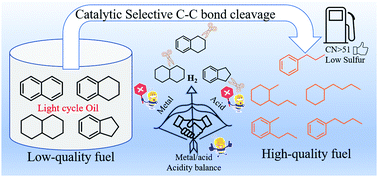Catalytic selective ring opening of polyaromatics for cleaner transportation fuels
Abstract
The selective C–C bond cleavage of mono- and bicyclic naphthenic molecules via catalytic ring opening plays a vital role in refining low-quality fossil oils and pyrolysis oils derived from municipal solid waste or waste biomass and tyres. Diesel fuels derived from such oils exhibit high polyaromatic content and low cetane number (CN), resulting in significant particulate emissions upon (inefficient) combustion. Catalytic upgrading of these oils via ring opening to form paraffinic molecules enhances their CN, producing cleaner burning fuels, with reduced particulate and sulfur emissions. Supported transition metal catalysts are attractive candidates for obtaining high-quality fuels by selective C–C bond cleavage of naphthenic molecules with high conversion. Ring opening of model polyaromatics can proceed through several reaction pathways, dictated by the catalyst, feedstock and reaction conditions, producing hydrocarbons with the desired CN. Identification of the active sites in supported transition metal nanoparticles responsible for different ring opening pathways is essential for the development of next-generation catalysts exhibiting higher selectivity and stability. Here, we critically review recent advances in the selective ring opening (SRO) of naphthenic molecules to paraffinic hydrocarbons (with high CN and low aromaticity), and discuss the impact of catalyst design on performance and reaction mechanism. Technical challenges in designing transition metal catalysts for SRO are discussed, and avenues explored for improving diesel fuel quality from low-grade feedstocks, including municipal solid waste.

- This article is part of the themed collection: EES symposium collection


 Please wait while we load your content...
Please wait while we load your content...